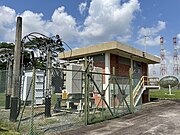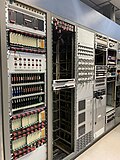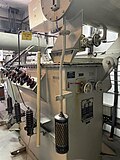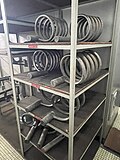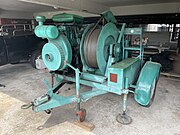BBC Far Eastern Relay Station
| Location | Lim Chu Kang, Singapore |
|---|---|
| Coordinates | 1°25′13″N 103°43′40″E / 1.4201524°N 103.7278319°E |
| Built | 1977 |
Between 1946 and 2023, the BBC Far Eastern Relay Station broadcast BBC World Service radio programmes to large parts of Asia on shortwave and longwave. Transmitting from a number of different sites, notably Tebrau in Malaysia (1947-1978) and then Kranji in Singapore (1978-2023), the station was one of a number of BBC "relay" stations around the world - so named because they "relayed" programmes primarily generated in London - including in Cyprus, Hong Kong and Oman.
Each site was built on a vast scale, comprising studios, a transmitter hall and giant feeder cables leading out to a large "aerial field" where masts carried a complex array of antennas for transmitting multiple radio programmes simultaneously to different destinations. At least in the case of the Tebrau site, there was also extensive on-site housing for several hundred multi-ethnic staff and their families, as well as sporting and social facilities.
It has been reported that - after over 75 years of broadcasting - the BBC Far Eastern Relay Station closed in July 2023, ending the short-wave service, as the site was also reportedly needed for development by the Singapore Government.[1]
History[edit]
In 1937 the BBC began planning a shortwave transmitting station to relay BBC World Service signals from the United Kingdom to the Far East.[1] As World War II began, a Marconi 100 kW HF sender (as the BBC termed transmitting equipment) was sent by sea to Singapore, but was lost when the vessel carrying it sank due to enemy action. A second attempt was thwarted by the advance of Japanese forces through Malaya. So it was not until after the end of hostilities, in 1946, that the BBC began broadcasting from four 10 kW Marconi type SWB11 transmitters at Jurong. This equipment, which had previously been used in Sri Lanka, now transmitted live programmes in English, Burmese, Indonesian and Thai from the purpose-built studios at Singapore's Cathay Building as The British Far Eastern Broadcasting Service. These studios moved to Caldecott Hill in 1949, a site which remained a centre for broadcasting in Singapore until 2015.[2] However, local generation of live BBC programmes ceased in 1951, with the exception of some English language announcements.[1] Programmes were now relayed from London using signals picked up by two Rhombic antennas and a Beverage antenna feeding AR-88 diversity and Mullard ISB type GRF552 receivers. This equipment was initially housed in an empty bungalow at the water filtering site at Woodleigh water filtering site, now part of Toa Payoh.
By 1947, the transmitting site had moved to Tebrau, Malaya. When, in the mid 1970s, it became clear that the BBC's licence to broadcast was not to be renewed by the Malaysian Government,[3] preparations began for relocation and the Tebrau site was sold off.[4] Christmas Island and Brunei were considered as possible locations. Meanwhile, the future status of the BBC relay station at Masirah, Oman was also in discussion as the British military base on which it had been built was being handed back to the host nation.[5]
Construction and operation[edit]

The Tebrau site (1947-1978)
The site, in Johor on the southern tip of Malaysia, covered 180 hectares of what was at the time virgin jungle. There were originally six transmitters - two 100kW Marconis and four 7.5 kW Marconis - and some 20 antenna masts, with power being generated by three enormous diesel electricity generators.[2]
By the early 1970s the Malaysian Government, sensitive to accusations that it was enabling the broadcast of British "propaganda", declined to renew the lease for the site. A number of other sites were considered by the BBC - including in nearby Brunei. No decision had been made when Singaporean Premier Lee Kuan Yew, who happened to be at the World Service's London HQ Bush House for an interview, was told about the problem during a casual meeting with a BBC Executive, and immediately offered Singapore as a site.[3]
The Malaysian Government agreed to annual extensions of the lease until the Tebrau site could be properly transferred to a new site at Kranji in Singapore. BBC Tebrau finally closed on 18 March 1979.
The Kranji site (1978-2023)
After the Government of Singapore offered a 30-acre site on Turut Track, Kranji, construction began on an antenna field initially comprising 17 towers supporting 14 Marconi 4-Band Kraus, 4 BBC dual-band and one 4 MHz array.[1] While the swampy ground required substantial earthworks, its proximity to salt water offered high electrical conductivity advantageous to effective radiation from the antennas. A transmitter hall similar to the design of Woofferton transmitting station was completed and 4 x 250 kW Marconi B6122 and 4 x 100 kW Marconi B6123 senders were relocated from Tebrau. This equipment began service on 1 February 1978 and installation was completed in March 1979.

By this time, the receiving station feeding the senders at Kranji had moved twice, first to Yew Tee Army Camp, where Plessey PRD200, Plessey PRD200, Racal RA133A Diversity and bandscanner receivers operated using an existing military antenna. That temporary arrangement was replaced on 1 December 1977 by a new receiving station at Sungei Punggol on the banks of the river. The receiving station building, a Marconi omni-directional antenna and one antenna tower were on dry land with the remaining 7 towers supporting 4 Rhombic and 2 sloping V aerials erected over the river estuary and only accessible by boat. 6 Plessey PRD200, 10 Channel diversity receivers, a Plessey PR2250 search receiver and a Plessey PR2250 receiver modified for bandscanning were now used to capture the signal to be relayed, all under remote control from the transmitting site at Kranji. The link between receivers and transmitters was carried by two paths to offer redundancy: a cabled PCM system, and a radio link on the hill at Bukit Timah. With the arrival of a satellite feed of the programmes from London, the Punggol receiving station was demoted to backup status until its closure in 1990.

During this period an extra tower and an array covering 15-21 MHz were added at Kranji, with automatic equipment to turn the senders on and off, to assign and slew the beam radiated from the antennas, to select programmes, and to control tape machines. In 1987, the installation of an additional Marconi BD272 250 kW transmitter brought from Daventry transmitting station increased the number of senders to 9, followed by another similar unit from Skelton transmitting station two years later. At its peak of operation in the 1980s, the station employed 55 staff and broadcast over 100 hours of programming daily, running up a monthly power bill exceeding SGD400,000.
-
Incoming power substation
-
Main control racks
-
One of several types of sender
-
Sender metering
-
Vacuum variable capacitor
-
Water cooled vacuum tube
-
Antenna coupling transformer
-
Modulation transformer
-
Modulation reactor detail
-
High voltage DC power supply
-
Coupling coils for various frequencies
-
Output coupling coil
-
Antenna feed lines and switch matrix
-
Antenna feedline switch
-
Phosphor-Bronze-Copper antenna wire
-
Antenna winch
Closure[edit]
Around the turn of the new millennium, the transmitting station at Kranji began relaying programming from other broadcasters, in addition to the BBC, including NHK World-Japan, Radio Canada International, Radio Australia, and Deutsche Welle.[1] Operation of the station passed from the BBC to a succession of private companies including Merlin, VT Communications, Babcock and Encompass. Following a decision by the Singapore Government to reassign and redevelop the area around the site, closure of the BBC Far Eastern Relay Station site and demolition of all its structures was announced in July 2023.[6]
References[edit]
- ^ a b c d Shacklady, Norman; Ellen, Martin (2003). ON AIR - A History of BBC Transmission. Wavechange Books. ISBN 9780954407711.
- ^ "Site of former Caldecott Broadcast Centre sold for S$280.9 million". channelnewsasia.com. Retrieved 31 August 2023.
- ^ "FCO 26/1844: BBC Far East Relay Station, Tebrau, Malaysia: transfer to Singapore". National Archives of Singapore. Retrieved 1 September 2023.
- ^ "FCO 26/1956: Foreign and Commonwealth Office Information, News and Guidance Departments. BBC Far East Relay Station. Singapore: sale of former site at Plentong, Malaysia". National Archives of Singapore. Retrieved 1 September 2023.
- ^ "FCO 8/2467 BBC relay station at Masirah, Oman". Arabian Gulf Digital Archives. Retrieved 1 September 2023.
- ^ Rosaleen Macbrayne. "BBC's call will continue after transmissions end". New Zealand Herald. Retrieved 30 August 2023.


